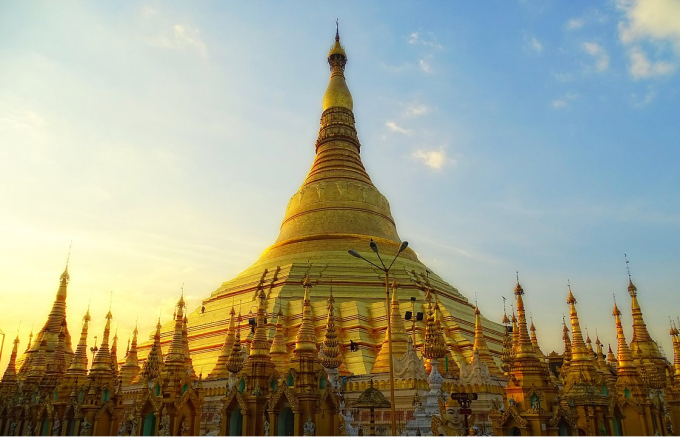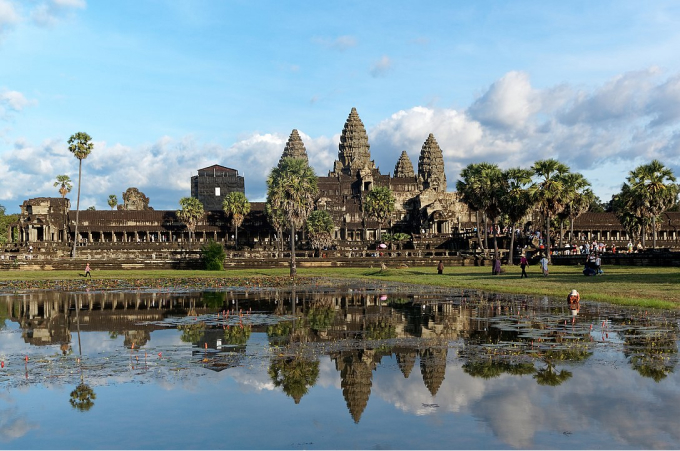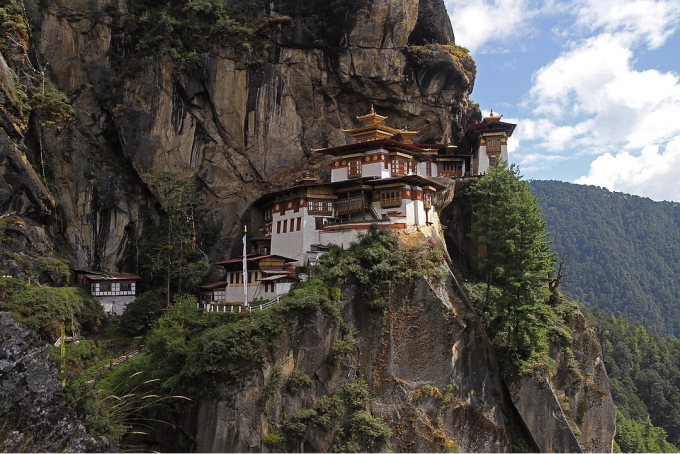10 Unique Buddhist Temples to Visit in Asia

Asia is home to some of the world’s most breathtaking and spiritually significant Buddhist temples. These architectural marvels not only showcase the beauty of Buddhist art and culture but also offer a serene and contemplative experience for visitors.
Here are ten remarkable Buddhist temples and a unique fact about them that make them worth exploring on your journey through Asia:
Quick Links – Buddhist Temples
- Shwedagon Pagoda, Myanmar
- Angkor Wat, Cambodia
- Borobudur, Indonesia
- Tiger’s Nest Monastery (Paro Taktsang), Bhutan
- Swayambhunath Monkey Temple, Nepal
- Dambulla Cave Temple, Sri Lanka
- Mahabodhi Temple, India
- Byodo-In Temple, Japan
- Ta Prohm, Cambodia
- Wat Rong Khun (White Temple), Thailand
1. Shwedagon Pagoda, Myanmar
Location: Yangon, Myanmar

Shwedagon Pagoda is one of the most sacred and impressive Buddhist temples in the world, with a towering stupa covered in gold leaf. It holds profound significance as one of the most sacred Buddhist sites globally, enshrining relics of the Buddha. It stands as a cultural and national symbol, showcasing Myanmar’s rich heritage through its architectural splendor.
With its historical and political importance, the pagoda has been a unifying force in the country, fostering interfaith harmony and preserving cultural traditions. It remains a symbol of peace and hope, drawing visitors from around the world to appreciate its spiritual and historical importance.
Unique Fact About Shwedagon Pagoda
- Shwedagon Pagoda is home to eight sacred hairs of the Buddha, making it a significant pilgrimage site for Buddhists. It’s one of the few pagodas in the world believed to contain relics from multiple Buddhas. These relics include the staff of Kakusandha Buddha, the water filter of Koṇāgamana Buddha, a piece of the robe of Kassapa Buddha, and eight strands of hair from the head of Gautama Buddha.
2. Angkor Wat, Cambodia
Location: Siem Reap, Cambodia

Angkor Wat, the world’s largest religious monument, beckons travellers with its architectural grandeur and rich cultural heritage. This Khmer masterpiece showcases intricate carvings and symmetrical design, offering a glimpse into Cambodia’s history and the Khmer Empire’s legacy. It stands as a symbol of both Hindu and Buddhist faiths, making it a place of spiritual reverence. Beyond its historical and cultural significance, Angkor Wat provides captivating sunrise views and an opportunity to explore the vast Angkor Archaeological Park, including nearby temples like Bayon and Ta Prohm. As a UNESCO World Heritage site, it’s a site of global importance, inviting visitors to delve into Cambodia’s past while embracing its warm local culture.
Unique Fact About Angkor Wat
- Angkor Wat is the largest religious monument in the world. It covers an area of 162.6 hectares (402 acres) and surpasses even the Great Pyramid of Giza in size. The temple is precisely aligned with the cardinal points of the compass, with its main entrance facing west and its five central towers mimicking the peaks of Mount Meru, the mythical home of the Hindu gods.
3. Borobudur, Indonesia
Location: Central Java, Indonesia

Visiting Borobudur in Indonesia is an opportunity to immerse yourself in the spiritual and architectural wonders of Southeast Asia. This UNESCO World Heritage site is the world’s largest Buddhist temple, renowned for its nine stacked platforms adorned with intricate relief carvings and bell-shaped stupas. As you ascend, you’ll discover captivating scenes from Buddhist cosmology and teachings. The temple’s unique design, with a breathtaking backdrop of volcanic peaks, makes it a destination for cultural exploration and a deep connection with Indonesia’s history and Buddhism’s profound spirituality.
Unique Fact About Borobudur
- The hill that sits beneath Borobudur is entirely man-made. It’s believed that millions of blocks of stone were cut, transported, and stacked to create this artificial hill, which serves as the foundation for the temple. This monumental engineering feat showcases the dedication and skill of the ancient builders who crafted Borobudur, making it an even more exceptional wonder of human achievement.
4. Tiger’s Nest Monastery (Paro Taktsang), Bhutan
Location: Paro Valley, Bhutan

The Tiger’s Nest Monastery in Bhutan is one of the more spectacular Buddhist temples in the world. This iconic monastery, perched on the edge of a cliff, not only offers a deep insight into Bhutanese Buddhism but also presents breathtaking views of the Paro Valley below. The challenging hike to reach this sacred site adds an element of adventure and makes the reward of standing amidst these ancient walls even more fulfilling. Tiger’s Nest is a testament to Bhutan’s spiritual heritage and its commitment to preserving its unique culture and environment, making it a must-visit destination for travelers seeking both cultural enrichment and natural beauty.
Unique Fact About Tiger’s Nest Monastery
- There are hidden meditation caves located within the cliffs surrounding the main temple. These caves were used by Buddhist monks for centuries as places of solitary retreat and meditation. Exploring these ancient hermitages offers a glimpse into the spiritual practices and deep contemplation that have been an integral part of this sacred site’s history. It’s a hidden gem within a well-known wonder, providing an even richer layer of spiritual significance to Tiger’s Nest.
5. Swayambhunath Monkey Temple, Nepal
Location: Kathmandu Valley, Nepal

Visiting the Swayambhunath Monkey Temple in Nepal is an enriching experience that combines spirituality, history, and natural beauty. This ancient stupa, perched atop a hill, offers panoramic views of Kathmandu Valley and the majestic Himalayas. As you explore this Buddhist temple’s architecture and intricate symbolism, you’ll gain insights into both Buddhism and Nepali culture. The playful monkeys that call the temple home add a touch of liveliness to the sacred atmosphere. Swayambhunath is a serene retreat from the bustling city, where you can immerse yourself in prayer, reflection, and the tranquil ambiance of this UNESCO World Heritage Site.
Unique Fact About Swayambhunath Monkey Temple
- Each of Swayambhunath Monkey Temple’s four sides is adorned with the all-seeing eyes of Buddha, symbolizing the wisdom of the five elements: earth, water, fire, air, and ether. These eyes gaze in all directions, signifying the Buddha’s omnipresence and the interconnectedness of all things. This remarkable depiction of the five elements makes Swayambhunath a profound and visually stunning representation of Buddhist philosophy and cosmology.
6. Dambulla Cave Temple, Sri Lanka
Location: Dambulla, Sri Lanka

Visiting the Dambulla Cave Temple in Sri Lanka is a journey into a world of ancient art, spirituality, and history. Carved into a massive rock formation, this UNESCO World Heritage site comprises a complex of five caves adorned with exquisite Buddhist murals and over 150 statues. The temple’s religious significance dates back over two millennia, making it one of the most revered pilgrimage sites on the island. As you explore the caves, you’ll be immersed in a serene atmosphere where devotion and artistic craftsmanship harmoniously coexist. Dambulla offers a profound cultural experience that allows you to connect with Sri Lanka’s rich heritage and appreciate the beauty of Buddhist art and architecture.
Unique Fact About Dambulla Cave Temple
- It dates more than 2,000 years. It is one of the oldest and most well-preserved cave temple complexes in Sri Lanka. Inside the five caves, you’ll find a stunning array of Buddhist murals and sculptures. These artworks depict various aspects of Buddha’s life and teachings, making the temple a remarkable showcase of Buddhist art.
7. Mahabodhi Temple, India
Location: Bodh Gaya, India

Visiting the Mahabodhi Temple in Bodh Gaya, India, is a profound and transformative experience for anyone seeking spiritual enrichment. This UNESCO World Heritage Site holds deep significance as the place where Siddhartha Gautama, the Buddha, is believed to have attained enlightenment under the Bodhi tree. The temple complex is not only an architectural marvel but a spiritual sanctuary that reverberates with centuries of devotion. As you walk through its sacred grounds and meditate beneath the Bodhi tree, you’ll be retracing the steps of the Buddha himself. It’s a place to find inner peace, gain insight into Buddhist teachings, and connect with the roots of a profound spiritual journey.
Unique Fact About Mahabodhi Temple
- The Mahabodhi Temple is the original site of Enlightenment. It marks the very spot where Siddhartha Gautama, the Buddha, is believed to have attained enlightenment. The sacred Bodhi tree is a direct descendant of the original tree under which he sat, making it a symbol of spiritual awakening and a significant pilgrimage site for Buddhists seeking enlightenment and inner peace.
8. Byodo-In Temple, Japan
Location: Uji, Japan

Visiting the Byodo-In Temple in Uji, Japan, is a journey into serenity and Japanese cultural heritage. This magnificent temple, surrounded by lush gardens and a reflective pond, exudes a profound sense of tranquility. It is a meticulous replica of the original Byodo-In Temple in Kyoto, which dates back to the Heian period. As you explore its ornate architecture, intricate woodwork, and iconic Phoenix Hall, you’ll be immersed in the ambiance of Japanese Buddhism. The temple’s serene environment, complete with a chorus of singing birds, offers a meditative retreat where you can appreciate the artistry, spirituality, and history of Japan.
Unique Fact About Byodo-In Temple
- It’s a meticulous replica of the original temple in Uji, Kyoto, which was built over a thousand years ago in 998. The temple’s iconic Phoenix Hall, with its graceful wings and reflecting pond, is one of Japan’s most recognized architectural masterpieces. It symbolizes the mythical bird of immortality and adds to the temple’s mystical charm.
9. Ta Prohm, Cambodia
Location: Siem Reap, Cambodia

Visiting Ta Prohm in Cambodia is a mesmerizing journey into the heart of the Khmer Empire’s rich history and the embrace of nature’s relentless reclamation. This UNESCO World Heritage site stands as a remarkable example of the intricate blend of spirituality and architecture. The temple’s ancient stone structures are intricately interwoven with towering silk-cotton trees and massive roots, creating a breathtaking, otherworldly scene. Exploring Ta Prohm is akin to stepping back in time and witnessing the power and mystique of the Khmer civilization. It’s a place that allows you to connect with both the spiritual legacy and the awe-inspiring forces of nature.
Unique Fact About Ta Prohm
- The “Tomb Raider Temple”. It made an appearance in the famous film, but it’s also renowned for a different reason – nature’s reclamation. The temple is engulfed by massive trees and their serpentine roots, creating an almost surreal, coexistent relationship between human architecture and the wild.
10. Wat Rong Khun (White Temple), Thailand
Location: Chiang Rai, Thailand

Visiting the White Temple, or Wat Rong Khun, in Chiang Rai, Thailand, is an experience that transcends the boundaries of traditional temple visits. This contemporary masterpiece of Buddhist art and architecture is a gleaming, all-white wonder that glistens in the sunlight. Its ornate details and intricate carvings are a true testament to the artistic vision of its creator, Chalermchai Kositpipat. Inside, you’ll find a blend of traditional Buddhist motifs and pop culture references, making it a unique fusion of ancient spirituality and contemporary creativity. The White Temple is not just a place of worship; it’s a visual and spiritual feast that offers insight into the fusion of tradition and innovation in the modern Buddhist world.
Unique Fact About Wat Rong Khun (White Temple)
- One of the more symbolic Buddhist temples in the world. The interior is adorned with captivating murals that combine traditional Buddhist themes with modern elements. You’ll find characters like Superman, Harry Potter, and even the 9/11 attacks depicted alongside traditional religious iconography, creating a unique blend of art and symbolism. To enter the temple, you cross a bridge that represents the cycle of rebirth, signifying the journey from the worldly existence to the enlightenment of the Buddha. The bridge is flanked by outreaching hands, symbolizing desire, and haunting faces, representing the traps of materialism.
These ten Buddhist Temples offer diverse experiences, from ancient and sacred to awe-inspiring and innovative. Each has its unique charm and significance, making them excellent destinations for spiritual exploration and cultural enrichment in Asia.


